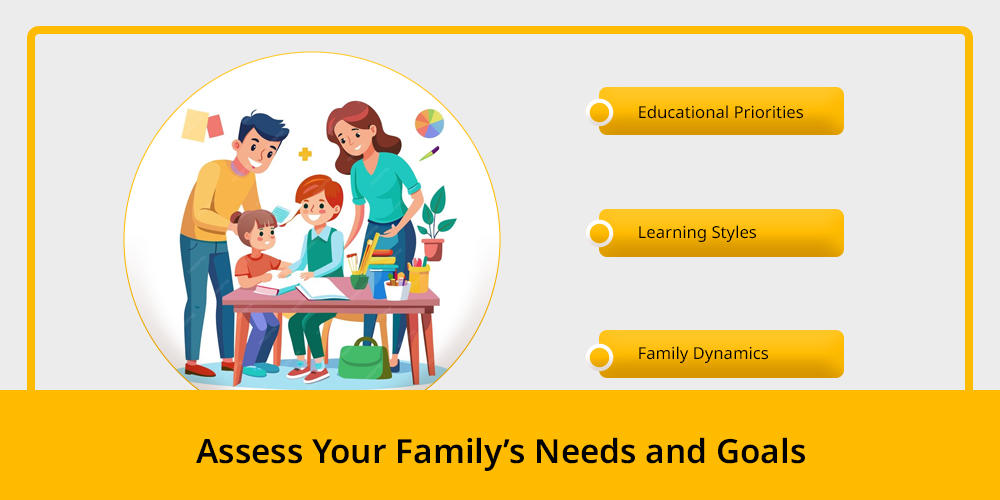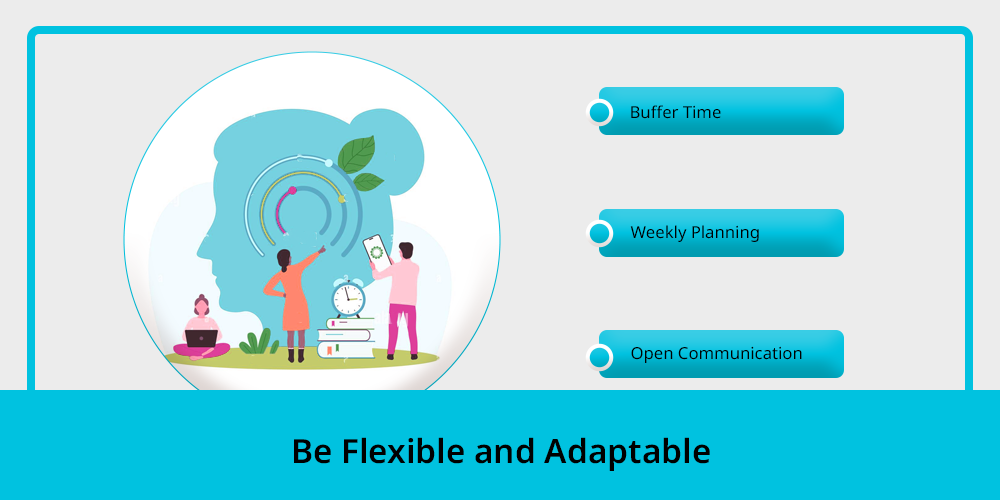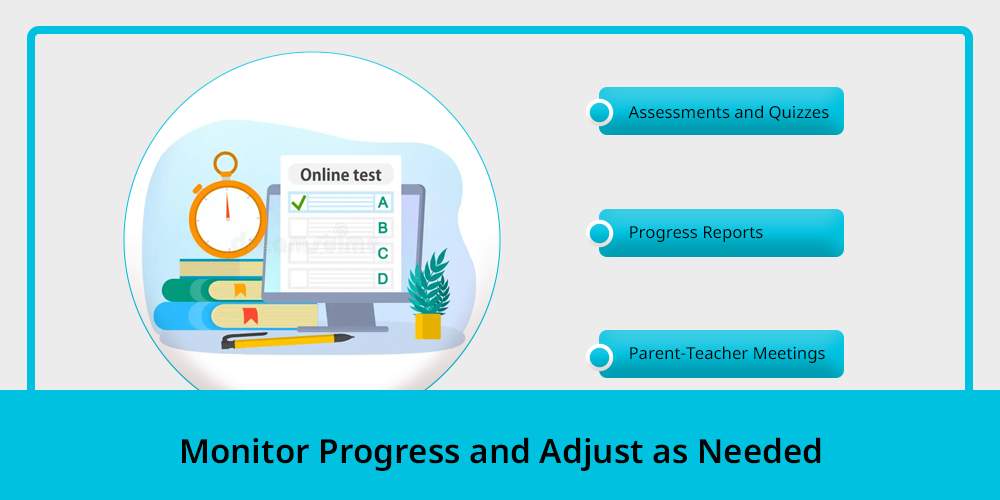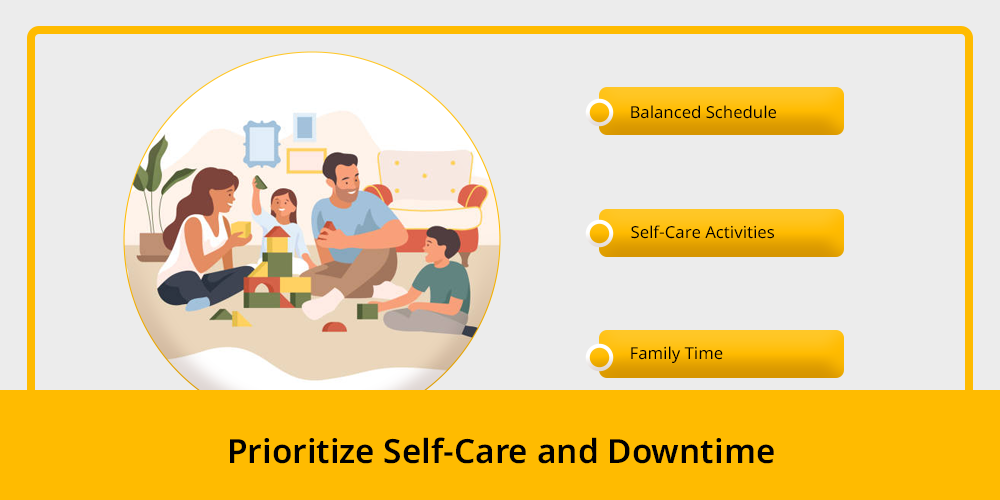
Homeschooling gives families the flexibility to provide education to their children according to their specific needs and interests.
But as it says, every good thing comes with some challenges too, similarly, the advantages of learning online also come with some crests and troughs, as you need to structure a good schedule otherwise it won’t be effective.
A well-crafted homeschooling schedule ensures that students’ time is not just spent getting a comprehensive education, but also having time for extracurricular activities and family life.
Thinking about how to make it? In this blog, we will give all the necessary tips for creating an effective homeschooling schedule.
Contents
7 Tips for Creating a Homeschooling Schedule
1. Assess Your Family’s Needs and Goals

It is important to consider your family’s needs and goals when you are creating a homeschooling schedule because it ensures that the schedule matches with family needs and aspirations.
Let’s understand this in detail below-
- Educational Priorities: If you want your children to focus on key subjects and skills you want them to have, you can make a schedule where sufficient time and resources are provided for these specific areas. For example, if you think subjects like Maths, Science, and Technology are important, you will give more time for maths and science activities each day, whereas if someone prioritises arts, they will provide more time for arts and music.
- Learning Styles: Each child has a different learning style. Some understand quickly with hands-on activities, whereas others choose reading and writing. While making the schedule, these things must be considered for a better learning experience.
- Family Dynamics: Understand your family’s regular routines, schedules, work, and other stuff as it helps you create a homeschooling schedule that matches your lifestyle. Notice factors like what are your parent’s working schedules, sibling activities, family other works, etc. By taking all this while making a homeschooling schedule, you can make a realistic and manageable plan that suits everyone’s needs and lets you make a balanced homeschooling schedule.
Read A Beginner’s Guide to Homeschooling: Getting Started as it will help the beginner to understand homeschooling more better.
2. Set Clear and Achievable Goals

While setting the goals, make sure they can be achieved because it keeps the student motivated and productive. These goals need to be relevant, time-bound, attainable, and measurable.
Let’s understand this by the examples below-
- Short-Term Goals: For short-term goals, add something like revising the tasks completed in the class. completing a textbook on any specific subject within a week.
- Long-Term Goals: For long-term goals, add something like getting a proper command of any subjects, let’s say, Maths, and complete everything by the end of this semester. Further, you can focus on building effective study habits and independent learning skills. The long term focus can be on the enhancement of problem-solving and critical thinking abilities.
It is essential to set goals because they provide direction and motivation to complete tasks on time. These habits not only help children today but also prepare them for the future.
3. Create a Daily and Weekly Routine

Making a daily and weekly routine provides structure and predictability, which benefits both parents and students.
Look at the pointers for precise details-
- Morning Routine: Make a habit of daily morning meetings where you discuss the plans of the day and also check what you have done earlier. You can review the previous day’s work, discuss upcoming assignments, or motivate your child by reading quotes or engaging in a positive activity.
- Core Subjects: Keep the timing of key subjects in the morning, as at this time students are fresh, focused, and alert. Further, for the rest of the subjects, allocate sufficient time to make sure there is balanced coverage.
- Breaks and Physical Activity: Try to give breaks in between the schedules so that students don’t feel grumpy and their focus remains maintained. Short breaks should be given between subjects, and a little longer break for lunch must be there. Focus on physical activities like yoga, stretching, or any outdoor games.
- Afternoon Activities: For the afternoon, add elective subjects, hands-on projects, and extracurricular activities to be done. This can include anything from art, music, science, sports, or more.
Top 5 Benefits of Co-Curricular Activities for Students to know what activities you can add and how they help you.
- End-of-Day Review: Now, when the day comes to an end, it’s time to review what the child has done the whole day. Talk about what he/she has learned, ask about their problems, and then plan for the next day.
Visit queries regarding homeschooling to clear all your doubts and get your question answered.
4. Be Flexible and Adaptable

It is important to have a schedule, but in homeschooling, the factor of flexibility holds the same significance. There will be days when the schedule is off track and you need to adjust that.
Here are some tips for maintaining flexibility:
- Buffer Time: One should always have some spare time set aside in case of any delay or any other activity that might occur in the course of the event. This can reduce possible stress and guarantee that important work and activities are done on time.
- Weekly Planning: Daily planning should be done at the beginning of the week after going through the weekly schedule and making any necessary changes. This makes the process of scheduling more flexible and thus can easily adapt to changes.
- Open Communication: Promote and encourage a free flow of communication with your young ones. Engage students in planning and be open to what they are saying. This can assist in coming up with a schedule that will suit him/her and everyone else.
5. Making Use of the Available Internet Resources

Appropriate online resources and tools could help your homeschooling schedule greatly. Platforms such as 21K School contain full-fledged educational programs and lessons, as well as help from expert tutors.
Here are some ways to integrate online resources:
- Supplemental Learning: Integrate computer-based instruction and videos to support the traditional lessons. This can also give additional explanations and or practice exercises which can help reinforce the concept being taught.
- Educational Apps: Integrate applications that include practice exercises, quizzes, and games along with education. These can make learning more fun, thus ensuring that the student has a favourable attitude towards the learning process.
- Virtual Field Trips: Use and explore museums, science and historical centres through virtual tours. These are the opportunities which can make the education of your children better and open their horizons.
6. Monitor Progress and Adjust as Needed

It is paramount to check on the children’s performance to be sure that the homeschooling timetable is effective.
Here are some strategies for tracking progress:
- Assessments and Quizzes: Regular Frequency is also important, therefore, set more inspections and quizzes to test understanding and retention. This can go a long way in establishing that there are rich areas that require more focus.
- Progress Reports: Prepare progress reports for increasing efficiency as well as for reporting what has been done and what is lacking. This can help to give a general picture of the current state of academic performance.
- Parent-Teacher Meetings: Schedule periodic meetings with your children’s teachers or tutors (if applicable) to discuss progress and make necessary adjustments to the schedule.
7. Prioritize Self-Care and Downtime

Homeschooling can surely be demanding sometimes not just for children but for the parents too. Here, you need to give some priority to self-care and off time for maintaining overall well-being.
Follow the tips below-
- Balanced Schedule: Make sure the schedule isn’t too strict.. Allow time for relaxation, hobbies, and family activities. This won’t make the child tedious of learning and promote a balanced work-life.
- Self-Care Activities: Increase your ‘me time’ by including activities like reading a good book, writing in a journal, and spending a few moments outdoors enjoying the fresh air. These small actions can help reduce stress and promote mental well-being.
- Family Time: There should be regular family time in the schedule as it makes the bonds good and gives memories that last longer. It can be anything you wish like game nights, parks, family outings, movie nights, etc.
Read What is SEL? An Insight into Social-Emotional Learning to know that along with academics, why emotional learning is important.
Sample Homeschool Schedule: Understanding Daily Routine
A sample homeschool schedule is an ideal option for time management and efficient study. It ensures a proper framework for learning.
Here we will understand the morning to night grade wise sample homeschooling schedule. Let’s begin with kindergarten.
1. Schedule From Kindergarten to Grade 2
- 7:30 AM – 8:30 AM: Morning routine, start with waking up then fresh up, exercise or fine motor skills activities and breakfast.
- 8:30 AM – 9:00 AM: Circle time (songs, calendar, weather)
- 9:00 AM – 10:00 AM: Doing some literacy activities such as phonics, reading.
- 10:00 AM – 10:30 AM: Take a snack and play break.
- 10:30 AM – 11:30 AM: Do some math activities like counting, basic age based operations.
- 11:30 AM – 12:00 PM: Creative arts class such as drawing and painting ideas for creative skills development.
- 12:00 PM – 1:00 PM: Lunch and rest sometime.
- 1:00 PM – 2:00 PM: Storytime and discussion.
- 2:00 PM – 3:00 PM: Outdoor play and physical activity like gross motor skills activities.
- 3:00 PM – 4:00 PM: Quiet time for playing puzzles, independent reading.
- 4:00 PM – 6:00 PM: Family time, talking and fun.
- 6:00 PM – 7:00 PM: Dinner with family learning table atticates.
- 7:00 PM – 8:00 PM: Fresh up and bedtime routine.
Balancing the daily tasks with online learning for your child is a tough task. But with a proper schedule everything can be managed.
Kids from kindergarten to 2nd grade are highly active and want to explore new things, add simple activities and include learning to make it fun.
2. Schedule From Grades 3 to 5
- 7:00 AM – 8:00 AM: Normal morning routine.
- 8:00 AM – 9:00 AM: Start with language arts like grammar and writing work.
- 9:00 AM – 10:00 AM: Mathematics homework.
- 10:00 AM – 10:30 AM: Take a snack break for balance.
- 10:30 AM – 11:30 AM: Theory subject science or social studies.
- 11:30 AM – 12:30 PM: Creative science projects or home experiments.
- 12:30 PM – 1:30 PM: Take a lunch break and free time to rest.
- 1:30 PM – 2:30 PM: Reading and comprehension, especially study.
- 2:30 PM – 3:30 PM: Physical education.
- 3:30 PM – 4:30 PM: Go to clubs or extracurricular activities to improve your hobbies.
- 4:30 PM – 6:00 PM: Family time and chores.
- 6:00 PM – 7:00 PM: Dinner time.
- 7:00 PM – 8:30 PM: Relaxation and bedtime routine and memories the whole day.
Children from grades 3 to 5 generally focus on learning basic skills like reading, writing, and math. This improves their strength for the future.
To solve middle and high school complex problems of maths and science students, teachers and parents need to ensure their base is strong.
3. Schedule For Middle School Students Grades 6 to 8
- 6:30 AM – 7:30 AM: Morning routine.
- 7:30 AM – 8:30 AM: Mathematics questions.
- 8:30 AM – 9:30 AM: Online class.
- 9:30 AM – 10:00 AM: Take a break.
- 10:00 AM – 11:00 AM: Start with other subjects like Science.
- 11:00 AM – 12:00 PM: Change the subjects such as social studies.
- 12:00 PM – 1:00 PM: Lunch time.
- 1:00 PM – 2:00 PM: Other native or any foreign language or elective.
- 2:00 PM – 3:00 PM: Physical activity on a daily basis.
- 3:00 PM – 4:00 PM: Language arts class for improvement.
- 4:00 PM – 6:00 PM: Family time and chores.
- 6:00 PM – 7:00 PM: Dinner time.
- 7:00 PM – 9:00 PM: Leisure activities and bedtime routine.
The middle school students between class 6 to 8 are usually between 11 and 13 years old and can follow the above schedule.
In this grade students focus on foundational skills and introducing more advanced concepts related to their subjects.
4. Schedule for High School Students Grades 9 to 12
- 6:00 AM – 7:00 AM: Morning routine
- 7:00 AM – 8:00 AM: Mathematics class
- 8:00 AM – 9:00 AM: Language arts class
- 9:00 AM – 10:00 AM: Science class
- 10:00 AM – 10:30 AM: Break
- 10:30 AM – 11:30 AM: Social studies class
- 11:30 AM – 12:30 PM: Elective or vocational subject.
- 12:30 PM – 1:30 PM: Lunch
- 1:30 PM – 2:30 PM: Regional or foreign language class
- 2:30 PM – 3:30 PM: Physical education class.
- 3:30 PM – 5:00 PM: Independent study or try some physics/science project or experiments.
- 5:00 PM – 6:00 PM: Family time, fun and play activities like creative painting ideas, drawing competition or writing.
- 6:00 PM – 7:00 PM: Dinner time.
- 7:00 PM – 9:00 PM: Homework and leisure. (take help or homework tips from elders or parents)
- 9:00 PM – 10:00 PM: Bedtime routine.
Schedule for high school students from grades 9 to 12 preparing for higher education or vocational training.
Understand what are the benefits of online high school for students.
By following these steps of schedule make them fully manage the whole day without lacking.
Homeschool Loop Schedule: Flexible for Students
A homeschool loop schedule includes rotating different subjects, concepts, activities, or lessons over a period, a week or in a month.
This approach is proven and ensures students get a more diverse and engaging learning experience. It is also helpful for student engagement.
Parents who look for different learning styles can opt for a homeschooling look schedule.
Explore the benefits of homeschooling in today’s evolving online education.
Here’s a detail steps how homeschool loop schedule works for students:
1. Planning the Loop
The planning starts with identifying the subjects or activities. So, ensure you have listed out all the essential subjects and activities.
All subjects and activities are going to rotate monthly or weekly. Determine how you want to do that.
Later divide everything into blocks. You need to structure each loop week with dedicated time slots for each subject or activity.
2. An Example of Homeschool Loop Schedule
A weekly homeschool loop schedule includes:
- Monday: Art, Math, Physical Education.
- Tuesday: Music, Reading, Science
- Wednesday: Outdoor gross motor activities, History, Language and Arts.
- Thursday: Math, History, Art
- Friday: Reading, Science, Music
3. Benefits of Using a Loop Schedule
There are many benefits of using a homeschool loop schedule by students. The process offers variety in study and increases interest in learning.
It is also popular due to its flexibility in curriculum and time management options for students.
4. Considerations for Loop Schedules
While implementing a loop schedule it is essential to balance flexibility with consistency. Remember effective resource management is crucial for every subject.
Parents involvement can also improvise planning and ongoing management. As a parent, ensure that child needs are fulfilled effectively.
Homeschool loop schedule is more than just planning. It is a cyclical approach to planning subjects that don’t require daily attention.
Adopting this approach, homeschooling families can enjoy the openness to accept the children’s schedule without compromising quality of online learning.
Online platforms like 21K School guide students to make an effective homeschool loop schedule and help them to follow accordingly.
Conclusion
When establishing a homeschooling schedule, one has to do it wisely, introduce a flexible program, and follow the needs of the family.
Again, when you evaluate your objectives, make a schedule, incorporate other resources on the net, and give time for personal attention, you can select right the right homeschooling program in a manner that will consider the developmental aspect of the child.
Some entities like; 21K School – a homeschooling platform through which students are provided with all the necessary tools and utmost assistance to enhance the homeschooling experience.
Never forget that the most efficient homeschooling timetable could be created when you can combine the learning process and your child’s development.


